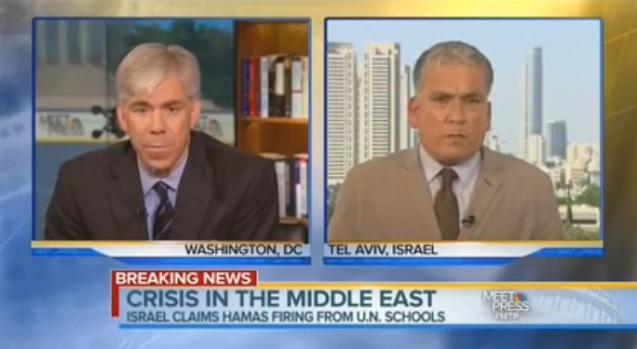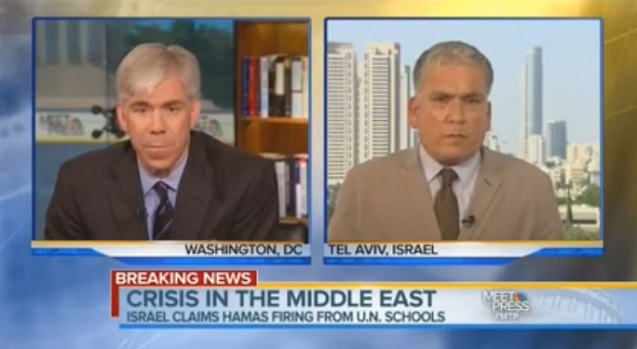
 via YouWatchMedia )” width=”637″ height=”349″ />NBC host David Gregory was forced to issue a correction at the end of his weekly “Meet the Press” program last month after a United Nations official confronted him for using an unconfirmed Israeli video that allegedly showed Hamas shooting rockets from a UN school. (Screen grab via YouWatchMedia )
via YouWatchMedia )” width=”637″ height=”349″ />NBC host David Gregory was forced to issue a correction at the end of his weekly “Meet the Press” program last month after a United Nations official confronted him for using an unconfirmed Israeli video that allegedly showed Hamas shooting rockets from a UN school. (Screen grab via YouWatchMedia )
It’s time to bring back a Washington institution.
Yesterday, Politico’s Mike Allen broke the news that Chuck Todd, NBC’s political director and chief White House correspondent, is the favorite to replace David Gregory and take over the helm at “Meet The Press.”
An official announcement on the switch is expected to be made in the next few weeks according to Allen.
Of course, this news doesn’t really come as a surprise to anyone who’s been watching “Meet The Press” of late.
Ever since the death of Tim Russert in 2008, “Meet the Press” has floundered, often finding itself at the bottom of the Sunday news show ratings.
In fact, the show has seen some of its worst ratings ever under David Gregory.
As a change looms at “Meet the Press,” it’s worth taking a look at how this once great pillar of political news television has ended up at the bottom of the ratings barrel, and how it can be made great again.
And to be fair, it’s not all David Gregory’s fault. Simply swapping him out for Chuck Todd won’t right the ship.
One of the major problems with “Meet The Press” of late is that the show assumes that its audience is not following the news, and has no clue about the week’s events.
But, as Jason Linkins points out over at The Huffington Post, the majority of the people that tune into “Meet the Press” are “well-versed in the stories of the week,” and have, “already absorbed the talking points of the major players, availed themselves of a wealth of insight and expertise, and have even participated in their own discussions on current events.”
Basically, the show’s producers appear to think its viewers are a lot dumber and a lot more uninformed than they actually are.
So, when people tune in on Sundays and hear the same old talking points from the same old pundits and politicos, they get bored and change the channel.
As Linkins puts it, “One doesn’t get the sense that the producers of ‘Meet The Press’ have in any way accounted for the sophistication of the show’s potential audience.”
And, since the show underestimates its audience, it brings on guests who really can’t contribute much to serious debates.
Similarly, the show rarely brings on experts on individual issues. Instead, it relies on political pundits, strategists, and analysts who are just reciting either bumper stickers or conventional wisdom.
That leads to a lot more “spin” on the issues, and fewer insightful discussions and debates.
The result is that big-name guests are thrown softball questions, instead of the hard-hitting grillings that the show was known for back in its early days.
Believe it or not, there was a time on “Meet The Press” when lawmakers who went on the show weren’t given the red-carpet treatment.
Instead, regardless of their political affiliations, they were barraged with questions, and often made to feel uncomfortable, all in the name of enlightening the American people.
So, those are some of the major problems that have dragged “Meet the Press” down in recent years.
Luckily, the show can be salvaged, and once again be a leader in political news television.
First, the show’s producers have to stop laying out the red-carpet for politicians who appear on the show.
It’s all about “access” to politicians – and because politicians have succeeded in intimidating the media, the producers are more concerned with maintaining relationships with politicians than they are with holding them accountable.
Going on “Meet the Press” shouldn’t be a walk in the park. Lawmakers and guests should be grilled, and if they feel uncomfortable, that’s a good thing.
Guests should be challenged on their beliefs and stances, so that the American people can have a well-rounded view of what’s really going on.
Look at a show like BBC’s “HARDtalk.” Instead of asking guests fluff questions and worrying about maintaining relationships, “HARDtalk” brings on some of the biggest names in politics, and still manages to hold their feet to the fire.
And right here on “The Big Picture,” I love getting into serious debates with big names, which illustrate the political issues involved.
I recently had Pat Buchanan on the show. Buchanan is still arguably one of the biggest names in Washington, and yet I made sure to ask him some tough questions and to hold him accountable for his beliefs.
If I can do it, “Meet The Press” can do it.
Next, instead of asking the same old beltway regulars the same old questions, and relying on boring panels, “Meet The Press” should be talking to experts on the issues, even if it means abandoning their current format, and doing more longform interviews and debates.
Look at Amy Goodman’s “Democracy Now!” for example, which dives deep into the issues that Americans really care about. Amy does longform interviews with expert guests and has serious discussions that cut through the “spin”, and that’s why “Democracy Now!” has been so successful.
And right here on “The Big Picture,” we consistently engage in deep discussions on the issues that matter with experts on those issues. Just last night we talked to three of the brightest minds on the current crisis in Iraq.
“Meet The Press” has definitely declined over the years, and today it’s just a shell of what it used to be.
But it can get back to being the Washington institution it once was.
When it comes to Sunday news shows, and really any news shows for that matter, Americans want a thoughtful analysis from a broad diversity of sources.
So, “Meet The Press,” give us a program that’s worth watching and we’ll watch it!
We’re not backing down in the face of Trump’s threats.
As Donald Trump is inaugurated a second time, independent media organizations are faced with urgent mandates: Tell the truth more loudly than ever before. Do that work even as our standard modes of distribution (such as social media platforms) are being manipulated and curtailed by forces of fascist repression and ruthless capitalism. Do that work even as journalism and journalists face targeted attacks, including from the government itself. And do that work in community, never forgetting that we’re not shouting into a faceless void – we’re reaching out to real people amid a life-threatening political climate.
Our task is formidable, and it requires us to ground ourselves in our principles, remind ourselves of our utility, dig in and commit.
As a dizzying number of corporate news organizations – either through need or greed – rush to implement new ways to further monetize their content, and others acquiesce to Trump’s wishes, now is a time for movement media-makers to double down on community-first models.
At Truthout, we are reaffirming our commitments on this front: We won’t run ads or have a paywall because we believe that everyone should have access to information, and that access should exist without barriers and free of distractions from craven corporate interests. We recognize the implications for democracy when information-seekers click a link only to find the article trapped behind a paywall or buried on a page with dozens of invasive ads. The laws of capitalism dictate an unending increase in monetization, and much of the media simply follows those laws. Truthout and many of our peers are dedicating ourselves to following other paths – a commitment which feels vital in a moment when corporations are evermore overtly embedded in government.
Over 80 percent of Truthout‘s funding comes from small individual donations from our community of readers, and the remaining 20 percent comes from a handful of social justice-oriented foundations. Over a third of our total budget is supported by recurring monthly donors, many of whom give because they want to help us keep Truthout barrier-free for everyone.
You can help by giving today. Whether you can make a small monthly donation or a larger gift, Truthout only works with your support.